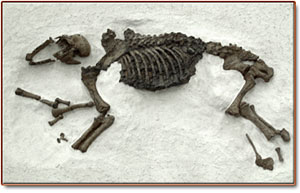Scimitar-toothed Cat

Scimitar-toothed cat (Homotherium serum) found in Friesenhahn Cave, Bexar County, Texas (TMM 933-3235, TMM 933-3497)
The scimitar-toothed cat Homotherium serum lived in Texas around 20,000 years ago but ranged widely in North America for almost 2 million years. These rare fossils are the complete skeletons of juvenile scimitar-toothed cats, or young kittens. The earth was not disturbed after the kittens died, so the fossils are well preserved. By studying the bones of these kittens scientists can learn about the growth and behavior of all saber-toothed cats. TMM 933-3235 is the larger kitten, and lived to be about four months old. TMM 933-3497 was about 2-3 months old when it died. The kittens would have grown to the size of an African lion, about 6 feet long and weighing around 300 pounds. But unlike lions these cats had longer front legs, and could easily run and leap upon prey. In fact, scimitar-toothed cats killed animals like young mammoths— larger than themselves— and dragged them into the cave. The cats used Friesenhahn Cave as a den, and more than 300 teeth from juvenile mammoths have been found there.
A Texas Memorial Museum field party including Glen Evans, Grayson Meade, Charles Mear, John White, Carl Moore, and Kenneth Rochat excavated at Friesenhahn Cave during the summers of 1949 and 1951. The group discovered the kittens and other fossils, including an adult scimitar-toothed cat.
You can see the kittens and the adult cat in the museum’s Hall of Geology and Paleontology.

